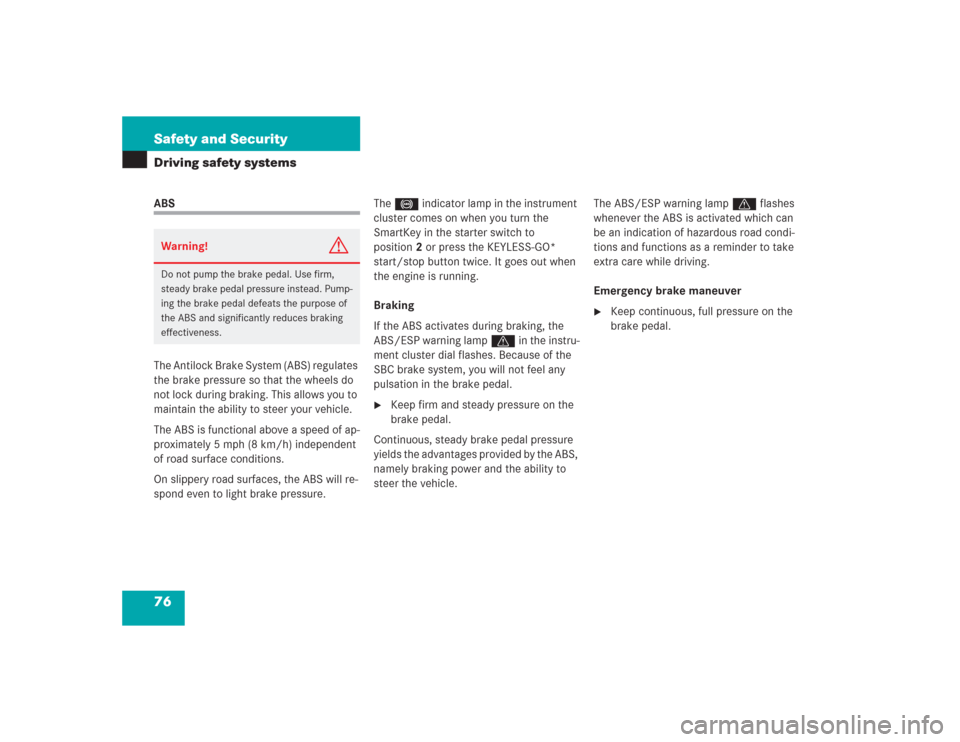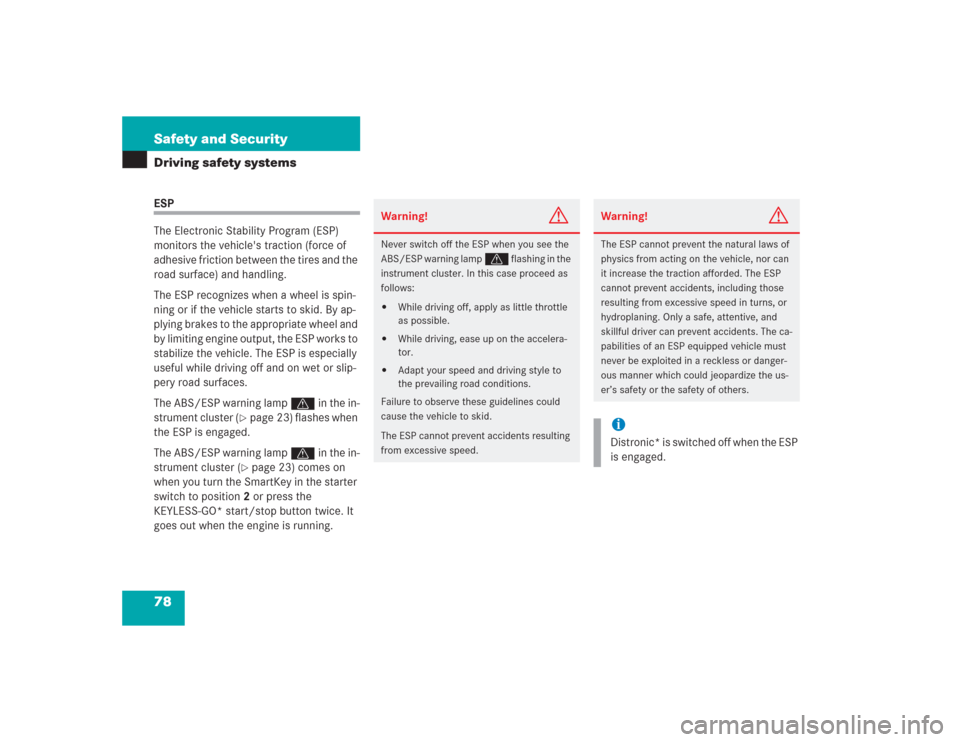Page 38 of 434

37 Getting started
Adjusting
Steering wheel Steering wheel adjustment
The stalk for steering wheel adjustment is
located on the lower left of the steering
column.
1Adjusting steering column, in or out
2Adjusting steering column, up or down
�
Switch on ignition
or
�
Open the driver’s door.Adjusting steering column in or out
�
Move stalk forward or back in the direc-
tion of arrow1 until a comfortable
steering wheel position is reached with
your arms slightly bent at the elbow.
Adjusting steering column up or down
�
Move stalk up or down in the direction
of arrow2.
Make sure your legs can move freely
and that you have a good view on all
the displays (including malfunction and
indicator lamps) on the instrument
cluster.
For more information, see “Heated steer-
ing wheel* (SL 500, SL 600)”
(
�page 220).
Warning!
G
Do not adjust the steering wheel while driv-
ing. Adjusting the steering wheel while driv-
ing could cause the driver to lose control of
the vehicle.
When leaving the vehicle, always remove the
SmartKey from the starter switch, take the
SmartKey with KEYLESS-GO
* with you and
lock your vehicle.
Even with the SmartKey removed from the
starter switch or the SmartKey with
KEYLESS-GO* removed from the vehicle,
the steering wheel adjustment feature can
be operated when the driver’s door is open.
Therefore, do not leave children unattended
in the vehicle, or with access to an unlocked
vehicle. Unsupervised use of vehicle equip-
ment may cause an accident and/or serious
personal injury.
iThe memory function (
�page 114) lets
you store the setting for the steering
wheel together with the settings for the
seat position and the rear view mirrors.
Page 40 of 434
39 Getting started
Adjusting
�
Make sure the ignition is switched on.
All the lamps in the instrument cluster
come on.
�
Press button1 for the left mirror or
button2 for the right mirror.
�
Push adjustment button3 up, down,
left, or right according to the desired
setting.
For more information, see “Good visibility”
(
�page 166).!If an exterior rear view mirror was forc-
ibly pushed forward (hit from the rear)
or forcibly pushed rearward (hit from
the front), reposition it by applying firm
pressure until it snaps into place. The
mirror housing is then properly posi-
tioned and you can adjust the mirror in
the usual manner.iThe memory function (
�page 114) lets
you store the setting for the exterior
rear view mirrors together with the set-
tings for the steering wheel and the
seat position.
Page 59 of 434

58 Safety and SecurityOccupant safety
�Occupant safetyIn this section you will learn the most im-
portant facts about the restraint systems
of the vehicle.
The restraint systems are�
Seat belts
�
Emergency tensioning device
�
Airbags
�
Child seats
�
Child seat recognition
As independent systems, their protective
effects work in conjunction with each oth-
er.The 1 indicator lamp in the instrument
cluster comes on
�
for about four seconds when you turn
the SmartKey in the starter switch to
position 1 or press the KEYLESS-GO*
start/stop button once. It then goes
out briefly, comes on again and re-
mains lit until you start the engine, turn
the SmartKey to position 2 or press the
KEYLESS-GO start/stop button once
more (
�page 30).
�
for about four seconds when you turn
the SmartKey in the starter switch to
position 2 or press the KEYLESS-GO*
start/stop button twice (
�page 30).
�
for about four seconds when you start
the engine by turning the SmartKey in
the starter switch or by pressing the
KEYLESS-GO* start/stop button once
with the brake pedal depressed
(�page 43).
The 1 indicator lamp goes out shortly
after you start the engine. This shows that
the restraint systems are operational.A malfunction in the system has been de-
tected if the 1 indicator lamp
�
fails to go out after approximately four
seconds
�
does not come on at all
�
comes on after the engine was started
or while driving
For more information, see the “Practical
hints” section (
�page 289).
iFor information on infants and children
traveling with you in the vehicle and re-
straint systems for infants and chil-
dren, see “Children in the vehicle”
(�page 70).
Page 77 of 434

76 Safety and SecurityDriving safety systemsABS
The Antilock Brake System (ABS) regulates
the brake pressure so that the wheels do
not lock during braking. This allows you to
maintain the ability to steer your vehicle.
The ABS is functional above a speed of ap-
proximately 5 mph (8 km/h) independent
of road surface conditions.
On slippery road surfaces, the ABS will re-
spond even to light brake pressure. The - indicator lamp in the instrument
cluster comes on when you turn the
SmartKey in the starter switch to
position2 or press the KEYLESS-GO*
start/stop button twice. It goes out when
the engine is running.
Braking
If the ABS activates during braking, the
ABS/ESP warning lamp v in the instru-
ment cluster dial flashes. Because of the
SBC brake system, you will not feel any
pulsation in the brake pedal.
�
Keep firm and steady pressure on the
brake pedal.
Continuous, steady brake pedal pressure
yields the advantages provided by the ABS,
namely braking power and the ability to
steer the vehicle.The ABS/ESP warning lamp v flashes
whenever the ABS is activated which can
be an indication of hazardous road condi-
tions and functions as a reminder to take
extra care while driving.
Emergency brake maneuver
�
Keep continuous, full pressure on the
brake pedal.
Warning!
G
Do not pump the brake pedal. Use firm,
steady brake pedal pressure instead. Pump-
ing the brake pedal defeats the purpose of
the ABS and significantly reduces braking
effectiveness.
Page 79 of 434

78 Safety and SecurityDriving safety systemsESP
The Electronic Stability Program (ESP)
monitors the vehicle's traction (force of
adhesive friction between the tires and the
road surface) and handling.
The ESP recognizes when a wheel is spin-
ning or if the vehicle starts to skid. By ap-
plying brakes to the appropriate wheel and
by limiting engine output, the ESP works to
stabilize the vehicle. The ESP is especially
useful while driving off and on wet or slip-
pery road surfaces.
The ABS/ESP warning lamp v in the in-
strument cluster (
�page 23) flashes when
the ESP is engaged.
The ABS/ESP warning lamp v in the in-
strument cluster (�page 23) comes on
when you turn the SmartKey in the starter
switch to position2 or press the
KEYLESS-GO* start/stop button twice. It
goes out when the engine is running.
Warning!
G
Never switch off the ESP when you see the
ABS/ESP warning lamp
v
flashing in the
instrument cluster. In this case proceed as
follows:
�
While driving off, apply as little throttle
as possible.
�
While driving, ease up on the accelera-
tor.
�
Adapt your speed and driving style to
the prevailing road conditions.
Failure to observe these guidelines could
cause the vehicle to skid.
The ESP cannot prevent accidents resulting
from excessive speed.
Warning!
G
The ESP cannot prevent the natural laws of
physics from acting on the vehicle, nor can
it increase the traction afforded. The ESP
cannot prevent accidents, including those
resulting from excessive speed in turns, or
hydroplaning. Only a safe, attentive, and
skillful driver can prevent accidents. The ca-
pabilities of an ESP equipped vehicle must
never be exploited in a reckless or danger-
ous manner which could jeopardize the us-
er’s safety or the safety of others.iDistronic* is switched off when the ESP
is engaged.
Page 80 of 434

79 Safety and Security
Driving safety systems
For more information, see the
“Practical hints” section (
�page 282).Switching off the ESP
To improve the vehicle's traction, turn off
the ESP in driving situations where it would
be advantageous to have the drive wheels
spin and thus cut into surfaces for better
grip such as:
�
starting out on slippery surfaces and in
deep snow in conjunction with snow
chains
�
in sand or gravelThe switch is located in the lower part of
the center console.
1ESP switch
�
Press ESP switch1 until the ABS/ESP
warning lamp v in the instrument
cluster comes on.
ESP is deactivated.
!Because of the ESP’s automatic opera-
tion, the engine must be shut off
(SmartKey in starter switch position 0
or 1 or KEYLESS-GO* start/stop but-
ton in position 0 or 1) when�
the parking brake is being tested on
a brake test dynamometer
�
the vehicle is being towed with the
front/rear axle raised
Active braking action through the ESP
may otherwise seriously damage the
brake system.
The ESP will only function properly if
you use wheels of the recommended
tire size (
�page 378).
Warning!
G
ESP should not be switched off during nor-
mal driving other than in the circumstances
described below. Disabling of the system
will reduce vehicle stability in standard driv-
ing maneuvers.!Turn on the ESP immediately if the
aforementioned circumstances do not
apply anymore.
iDistronic* cannot be activated when
the ESP has been deactivated.
��
Page 81 of 434
80 Safety and SecurityDriving safety systemsIf one or more drive wheels are spinning,
the ABS/ESP warning lamp v in the in-
strument cluster flashes, regardless of the
speed.
Traction control brakes a spinning wheel
even when the ESP is deactivated.
The ESP always operates when you are
braking, even when it has been deactivat-
ed.Switching on the ESP
�
Press ESP switch1.
The ABS/ESP warning lamp v in
the instrument cluster goes out.
You are now again in normal driving
mode.
!Avoid spinning of a drive wheel for an
extended period with the ESP switched
off. This may cause serious damage to
the drivetrain which is not covered by
the Mercedes-Benz Limited Warranty.Warning!
G
When the ABS/ESP warning lamp
v
is
illuminated continuously, the ESP is
switched off.
Adapt your speed and driving to the prevail-
ing road conditions and to the non-operating
status of the ESP.
��
Page 90 of 434
89 Controls in detail
Locking and unlocking
Seats
Memory function
Lighting
Instrument cluster
Control system
Automatic transmission
Good visibility
Automatic climate control
Power windows
Retractable hardtop
Driving systems
Useful features